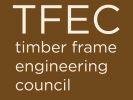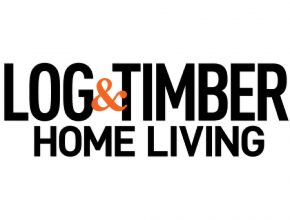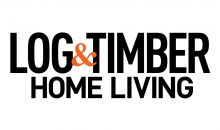2018 TFEC Code of Standard Practice released
A big thanks to the TFEC for developing the new 2018 edition of the TFEC Code of Standard Practice for
Timber Frame Structures. The original code was written in 2013 and has now been reviewed, amended, and reissued. It provides a thoughtful overview of what most of us in the timber frame business do on a daily basis, offering a simple standard that can be broadly accepted by the industry to be used to define roles in the process, define responsibilities, set basic standards, help answer building code questions, and, in a worst case scenario, help defend us if we end up in a dispute.
I must say that when I first saw the Code of Standard Practice several years ago, I immediately dismissed it as another attempt from someone else to tell me how to do my job. Now, having spent some time reviewing it and talking to the folks involved in its creation and revision, I realize it is the opposite: it is simply a written definition of the work we do. I am not in the shop or in the field as much as I once was, so I had some of my crew and a few others review it with me. There was little to no objection to any element of the document.
One of the highlights for me is that it is only eight pages. Last week I received a specification book for a
relatively small project that was 254 pages, so eight sounds pretty good to me. When I reviewed the new TFEC document I was particularly happy with the first paragraph: the preface states that “this document is an ordinary and acceptable practice” and any provisions to the contrary stated in a contract document are beyond the scope of the Code of Standard Practice. So right from the start, it says that this is the standard, but we can change anything we want in our contracts or agreements with our clients. An easy in, and an easy out.
It covers topics from timber grading to shop drawing 2018 TFEC Code of Standard Practice released and engineering, from fabrication tolerances to erection standards. Nothing in it is too lofty or beyond what I
think most of us work to achieve every day. Something I realized after reading this is that it offers a real sense of professionalism to our work and our industry. It shows that our efforts go beyond the great projects and nice joinery that we are all putting out—it says that as an industry, we are contributing resources to developing professional standards. We are taking time and money to evaluate the quality and integrity of what we do. This is one of the great resources of the Timber Framers Guild, the bringing together of all the parts of the timber framing community to further the craft and strengthen our businesses.
I plan to start attaching this to my company’s proposals. I see that it will do three things for us:
- it shows up front what we plan to offer clients in our product;
- it shows that we (as a company) are involved in the big picture of the industry; and
- it shows that there is a professional group, the Timber Frame Engineering Council, involved and backing up the work we do.
God forbid we ever end up in a dispute over our work, but this will be front and center to back us up.
I also will have a copy in the shop and on our jobsites, so that we all know the basic standards to which we are agreeing. I encourage other timber framers to follow suit—including this document as a supplement to each contract and then carefully reviewing it with clients will form a baseline for expectations on projects, ultimately saving time, resources, and future headaches!
Many thanks to the TFEC and others involved—your hard work makes our Guild and industry stronger!
Click on a photo to enlarge.
This blog article has been viewed 238 times.
Posted
Apr 20, 2018 3:40 PM PST.
Edited on Apr 23, 2018 8:55 AM.report
New Blog Posts
- Hidden Trace Farm CBW: Arrival
285 views - Heartwood 2020: Timber Framing II
249 views - Heartwood 2020: Timber Framing Intensive, July 9
117 views - Heartwood 2020: Timber Framing Intensive, July 10
223 views - Heartwood 2020: Timber Framing Intensive, July 7
84 views - Heartwood 2020: Timber Framing Intensive, July 8
110 views - Ekvn-Yefolecv Roundhouse CBW, Day 4 (November 4, 2019)
375 views - Ekvn-Yefolecv Roundhouse CBW, Days 2 & 3 (November 2&3, 2019)
249 views - Before the Build, Ekvn-Yefolecv Roundhouse CBW (October 31, 2019)
221 views - Ekvn-Yefolecv Roundhouse CBW, Day 1 (November 1, 2019)
311 views - After the Sunrise Build: Thank You from the Guild
164 views - Day 7, Sunrise Mill CBW (October 4, 2019)
360 views - Day 6, Sunrise Mill CBW (October 3, 2019)
210 views - Day 5, Sunrise Mill CBW (October 2, 2019)
208 views - Day 4, Sunrise Mill CBW (October 1, 2019)
172 views - Day 3, Sunrise Mill, September 30, 2019
219 views - Day 1, Sunrise Mill, September 28, 2019
228 views - Day 2, Sunrise Mill, September 29, 2019
225 views - Su Casa - Summer 2019
67 views - The Work Goes On: Day Two at Lake Roesiger
Lake Roesiger Community Building Workshop continues, with "more of the same"...
298 views - Orientation, Organization, Layout, and Fabrication: Day One at Lake Roesiger
Day One of the Lake Roesiger Community Building Workshops in Snohomish...
224 views - The Stage is Set: Lake Roesiger Community Building Project
"Day Zero" at the Lake Roesiger Community Building Workshop (Snohomish County,...
186 views - Guild Member reflections on the Notre Dame Fire
Notre Dame Fire Reflections
210 views - 3rd Timber Framers Gathering of Australia in the Grampians, VIC 27/28th October 2018
275 views - Weekly Guild Note -31 August 2018
Complex Roof Workshop to be offered at the Eastern Conference. North...
132 views - Review of Timber Innovation Act and 2018 Farm Bill
196 views - Unforgettable: Timber Framers Guild Western Conference
123 views - Your TFG Dashboard Tutorial
47 views - View from Here, Scantlings Issue 214, April 2018
72 views - 2018 TFEC Code of Standard Practice released
238 views - RFQ for Project Manager for 2018 TFG Community Building Projects
Timber Framing, Project managers
101 views - Thank you Ellen and Rick!
116 views - Everyday Craft
76 views - TFG collaboration with Kennebec Valley Community College
176 views - Brand Camp Re-Cap
64 views - Build Your Brand, Build Your Circle, Build Your Influence - Part One
126 views - Let’s Talk About Search Engines and SEO
93 views
Recent Comments
- Guild Member reflections on the Notre Dame Fire
Notre Dame Fire Reflections
1 comment 210 views
Apr 30, 2019 2:00 PM - TFG collaboration with Kennebec Valley Community College
1 comment 176 views
Mar 21, 2018 4:03 PM - Review of Timber Innovation Act and 2018 Farm Bill
1 comment 196 views
Aug 10, 2018 6:27 PM - Everyday Craft
1 comment 76 views
Mar 3, 2018 9:41 AM







